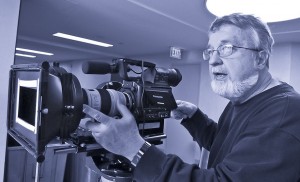- About Przyborski Productions
- Show Reels
- Misc Videos
- Introduction of 24P (from 2002)
- Americana
- Images from a Summer Carnival
- River Rafting
- Scenes from a County Fair
- America Lost
- Moments@24fps (1999)
- Behind-the-Scenes Prop38 (2000)
- 1991 Pittsburgh Penguins
- Barth Bartholomae (1997)
- Behind-the-Scenes Pagetime (1998)
- Frontier Telephone (2000)
- Time Capsule: GNC 1993-1996
- Glenn
- Jimmy D
- Map
- Contact Info
- Scrapbook
The biggest trend in commercial production is to create images with very shallow, film-like depth-of-field. This “look” was easy with 35mm movie film. As a general rule, the larger the film frame or imaging device, the “tighter” the depth-of-field and more selective the focus. This contrasts with previous HDTV digital cameras that achieved sharp focus throughout the entire frame.
Although I love film and have shot over 2,000,000 feet of it… today’s budget for a typical spot doesn’t have the luxury of $10K to $20K for 35mm film stock, processing, HDTV transferring and sync-ups.
Using “film-like” shallow depth-of-field to separate actors or products from a scene’s background can now be achieved with new, cost-effective cameras from Sony and Panasonic. They use large scale digital imagers that approximate the size of 35mm film negative. Since these cameras record to solid state memory, there’s no added size, weight or expense related a tape mechanism.
I recently shot a series of commercials with Panasonic’s new AF100. I love the fact that all my Canon and Nikon 35mm lenses work perfectly with this camera. Plus, it will shoot 1080P, true slow-motion at 60 frames-per-second. I don’t have a lot in common with James Cameron, but we both agree that professional cameras need to be smaller and lighter. Technology marches on…



If you don’t mind me asking, what scene file settings are you using for your AF100? I’ve found they’re extremely important to what kind of footage this thing can put out. If you’re not willing to share here on the blog, could you possibly email me? I’ve been testing different settings for a while but I haven’t found anything I’m very confident of.
Hey Kyle,
I’ve worked in high-end broadcast production most of my adult life and here’s my 2 cents worth and how I setup my cameras…
If you’re shooting with an AF100, chances are that the footage you shoot is going to be edited by either you or someone else. After editing, someone will probably do some form of color correction (excuse me… “grading”) to your project before it’s released.
I’ve learned a long time ago that it’s best to start the post-production process with images that are well-exposed, in-focus, with good overall color balance, and absolutely no black clipping or unusual gamma induced contrast. Remember, on the AF100, you only have 256 steps from black to white. Give yourself as much latitude as possible for final “grading” during post-production. I always add the film-like “S-gamma curves” and crushed blacks in post, not in camera.
If you set your camera to crush or deepen low-lights or shadows within a scene, your will see noise and compression artifacts as soon as you try to recover low-light details in post. Also, IMHO the chroma and luminescent channels of the AF100 don’t precisely track each other as they approach white clip, which for some reason, Panasonic uses 110 units of video instead of the usual 100 to 103 units. This means that you need to use a “Broadcast Safe” filter at the bottom of your color correction filters.
For what it’s worth, here’s the settings I use on my AF100…
180 degree shutter
Scene Select F1
Operation FILM CAM
REC Format PH1080/24P
Detail Level -4
V Detail Level -3
Detail Coring 0
Chroma Level 0
Chroma Phase 0
Master Pedestal 0
DRS OFF
Gamma HD NORM
Knee LOW
Matrix NORM1
Skin Tone DTL OFF
You will also find (I’ve seen it in 2 cameras) that there seems to be a slight green bias when you use the “auto white function” If you set “COLOR TEMP Ach” and “COLOR TEMP Bch” both to +2 the problem goes away. It’s highly possible that your camera doesn’t do this, but if it does, that’s how to correct it.
One other thing… For the highest quality images, shoot at 1080P, not 720P. If you want to release a final product in 720P, downsample your 1080P edited master. I don’t want to start a controversy, but virtually every major TV show and TV commercial, whether originated in 35mm or digital, is post-produced and mastered in 1080P.
Another tip with the AF100… I’ve found it very helpful to set the color on the LCD monitor to “0”. The allows me to really see the red in-focus highlights and If you light to achieve a good looking B&W image, you’ll never go wrong.
Hope that helps…